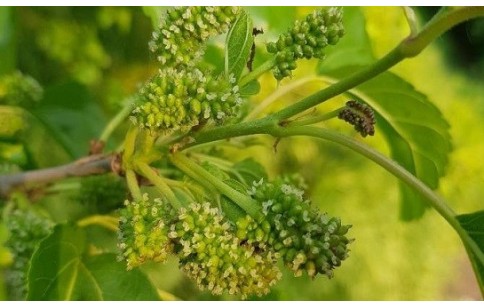- Code : #0909 S 20 mg
- Formula : C₁₅H₁₁O₆Cl
- CAS : 528-58-5
Morus alba
Morus alba, “White mulberry” in English and “Mûrier blanc” in French, belongs to the Moraceae botanical family. Originally endemic to Central and Northern China, it is now widely cultivated throughout the world.
The species is a shrub or tree, 3 to over 20 m tall. Its leaves provide food for silkworms and its bark fiber is used for textiles and paper.
It has a long history of use in traditional Chinese as well as Ayurvedic medicine. Most parts of the plant have a medicinal use.
Research has validated its many pharmacological activities : antidiabetic, antimicrobial, antimutagenic, antioxidant, anticancer, anxiolytic, anthelmintic, antistress, immunomodulatory, hypocholesterolemic, nephroprotective and hepatoprotective.
Its main components are ascorbic acid, carotene, vitamin b1, folic acid, folinic acid, isoquercetin, quercetin, tannins, flavonoids (morin) and saponins. Typical pigment of its fruits are keracyanin and kuromanin.

- Code : #1124 S 20 mg
- Formula : C₁₅H₁₀O₆
- CAS : 520-18-3
- Code : #0914 S 10 mg
- Formula : C₂₇H₃₁O₁₅Cl
- CAS : 18719-76-1
- Code : #0915 S 10 mg
- Formula : C₂₁H₂₁O₁₁Cl
- CAS : 7084-24-4
- Code : #1344 S 20 mg
- Formula : C₁₅H₁₀O₇
- CAS : 480-16-0
- Code : #1135 S 20 mg
- Formula : C₁₅H₁₀O₇,2H₂O
- CAS : 6151-25-3
- Code : #1327 S 20 mg
- Formula : C₂₁H₂₀O₁₂
- CAS : 482-35-9
- Code : #4963 S 20 mg
- Formula : C₁₄H₁₂O₃
- CAS : 501-36-0
- Code : #1139 S 50 mg
- Formula : C₂₇H₃₀O₁₆
- CAS : 153-18-4










